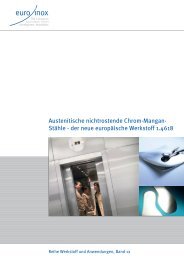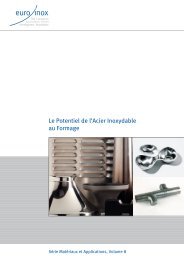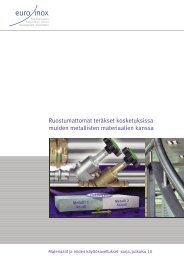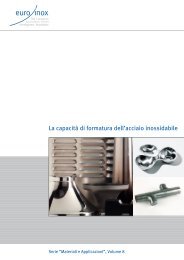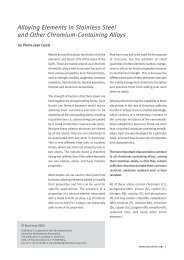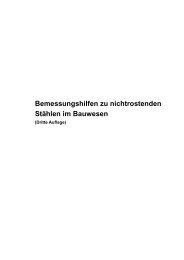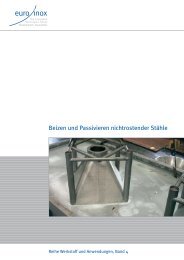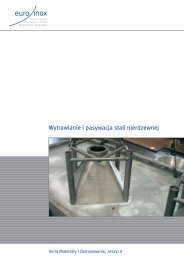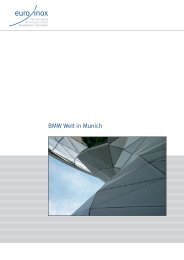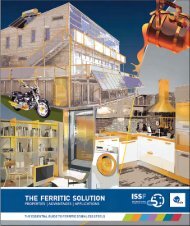Stainless Steel - The Safe Choice - Euro Inox
Stainless Steel - The Safe Choice - Euro Inox
Stainless Steel - The Safe Choice - Euro Inox
Create successful ePaper yourself
Turn your PDF publications into a flip-book with our unique Google optimized e-Paper software.
Consequently, most metallic alloys in the<br />
“massive” form (which represents more than<br />
99 % of total metallic alloy production in the<br />
world) are considered to present no risk to<br />
human health.<br />
5.1 <strong>Stainless</strong> steel in contact with skin<br />
Although Nickel release from nickel-plated<br />
materials may induce allergic contact dermatitis,<br />
for nickel-containing stainless steels<br />
(i.e. austenitic stainless steels) the effect is<br />
much different.<br />
<strong>The</strong> aim of recent studies (11,12,13) was to<br />
define the risk of nickel contact dermatitis<br />
from AISI 304 (1.4301), AISI 316L (1.4404)<br />
and AISI 430 (1.4016) grades as well as a<br />
high sulphur containing stainless steel grade<br />
AISI 303 (1.4305) and a nickel-plated steel.<br />
Methods included nickel release in synthetic<br />
sweat, electrochemical investigations, and<br />
clinical patch tests on already sensitised persons.<br />
Table 1. gives the chemical composition<br />
of the different materials used in the<br />
studies. <strong>The</strong>se grades will be identified using<br />
the AISI and the <strong>Euro</strong>pean standards.<br />
Leaching experiments were performed mainly<br />
in artificial sweat solutions at pH 4.5 at room<br />
temperature for one week. Composition of<br />
the artificial sweat solution was as follows :<br />
0.3 % NaCl, 0.1 % Na2SO4, 0.2 % urea and 0.2<br />
% lactic acid. <strong>The</strong> stainless steels were also<br />
tested according to the standardised test (pr<br />
EN 1811). <strong>The</strong> method described therein was<br />
developed for implementation of the 12th amendment (Directive 94/27/EC) to Directive<br />
76/769/EEC relating the restrictions of the<br />
marketing and use of certain dangerous substances<br />
and preparations. <strong>The</strong> composition of<br />
the artificial sweat solution was as follows :<br />
0.5 % NaCl, 0.1 % urea, 0.1 % lactic acid,<br />
and NH3 to adjust the pH at 6.6.<br />
Electrochemical investigations were carried<br />
out to compare the stability (passivity/activity)<br />
of materials in different solutions. Corrosion<br />
(activity) and corrosion resistance<br />
(passivity) of metals and metallic alloys are basically<br />
electrochemical processes. Electrochemical<br />
tests were conducted in synthetic<br />
sweat solutions at pH 4.5 and 6.6. Samples<br />
were tested in the as received conditions or<br />
wet-polished.<br />
Clinical patch tests were performed on 50 already<br />
Ni-sensitised persons, with circular<br />
samples of the four stainless steel grades<br />
and of the Ni-plated steel in the as received<br />
conditions. <strong>The</strong> patch tests were removed after<br />
2 days of exposure, and readings were<br />
carried out 30 min after.<br />
<strong>The</strong> results of leaching experiments in the<br />
synthetic sweat-solutions show three groups<br />
of materials characterised by three different<br />
levels of nickel migration:<br />
SAFE STAINLESS STEEL<br />
Grade AISI 303 AISI 304 AISI 316L AISI 430 Nickel<br />
1.4305 1.4301 1.4404 1.4016<br />
C 0.064 0.036 0.021 0.037<br />
Si 0.54 0.49 0.61 0.33 0.01<br />
Mn 1.79 0.81 1.67 0.43<br />
Ni 8.45 8.65 11.29 0.11 99.8<br />
Cr 17.25 18.18 17.87 16.59<br />
Mo 0.26 0.26 2.15 0.11<br />
S 0.2753 0.0069 0.0018 0.0010 0.0020<br />
Table 1: Chemical composition<br />
(wg %) of the<br />
stainless steel grades<br />
and nickel used in the<br />
Ni allergy study<br />
© <strong>Euro</strong> <strong>Inox</strong> 2002 www.euro-inox.org · 5



